Since our inception in 2010, we have measured both our financial returns and our mission. We think this is where the world is going, but very few bother to do it. Having experimented with for-profit do-goodery for 30 years now, I have found that for-profits typically overstate their mission and non-profits often overmeasure it (thanks to risk averse donors). The former can be a slippery slope to becoming a bad actor. The latter can readily lead to sub-par outcomes. Even though most people agree that “what’s measured gets managed,” very few actually measure progress against their mission, a company’s self-proclaimed raison d’etre. We do, and we’re open sourcing it on Github, so you can, too.
If your business model aligns commercial success with achieving the mission, which most CEOs and VC’s glibly presume, then your CFO and accounting firm should be able to tell you if you’re achieving your mission. But, as the former executive team at Wells Fargo (and so many others) can tell you, picking the right proxies for success is a minefield. And, you shouldn’t blindly assume that if you’re making money the world is becoming a better place. Test it. Measure it, like you measure everything else!
So many VC’s and tech startup founders do what you do on the premise you are solving society’s greatest problems: in fintech, democratizing financial advice, increasing access to robo-investing, lowering the cost of basic banking, optimizing insurance coverage, etc. Yet, almost no one measures it.
There is a glaring lack of consensus on the correct approach to impact measurement, the appropriate level of precision, and the degree to which impact data should play a role in an organization’s decision-making. By the way, this was true in basic accounting, as well. GAAP wasn’t adopted formally by the SEC until the 1930s. FASB wasn’t established until the 1970s. So, in order for impact measurement to fulfill its promise of producing massive improvements in organization effectiveness, certain principles of impact measurement should become generally accepted. Various standards exist, but we found most of them tried to boil the ocean and were too onerous to execute regularly.
At Core, we believe impact measurement is of vital importance to the effective allocation of capital. In the spirit of open innovation and moving the industry forward, we decided to open source our impact measurement methodology for the industry to utilize and improve upon. Here it is, on Github.
Why We Measure Impact
Core was founded on the principle of “missionary results and mercenary returns”, seeking to achieve fantastic returns by investing in companies which enable financial emancipation. Consequently, we have been actively measuring the impact of our portfolio since before “impact measurement” became a buzzword. In fact, impact measurement has always been a key tenant of our process because we firmly believe you are only able to improve what you measure.
For an organization to be serious about creating social value, or any positive externalities, anecdotes are simply insufficient. Lacking impact measurement, it would be impossible to set and attack organizational goals that reflect tangible improvement in the lives of real human beings. Core has set out to improve the lives of 200 million people by 2035, with at least 90% of that audience coming from the bottom three income quintiles. Along the way, we aim to produce $1 trillion in aggregate wealth creation, cost savings, and risk mitigation for consumers. Without a robust set of impact measurement tools and systems, these targets would be completely meaningless and incapable of guiding our decisions. Our organizational mission would be entirely ethereal. We would be playing in the dark.
By applying appropriate impact measurement at Core, just as we do with our accounting, we are able to keep our goals in focus. Maintaining emphasis on the impact we seek has honed our investment process and allowed us to impact over 25 million people with over $168 billion in value creation since 2010.
Moreover, integrating impact measurement as a critical component has enabled us to improve our impact measurement process over time. By keeping our attention on impact results, we are constantly seeking new and better ways to enhance our ability to measure impact. Refining our methodology has created a virtuous cycle in which better impact measurement leads to more valuable insights which leads to greater attention to impact measurement and a higher likelihood of the system being improved.
How We Think About Impact Measurement
The central premise of Core’s perspective is that impact measurement should always be practical. While academic research can be useful for collecting ideas and frameworks, an organization should always design a methodology that fits with its priorities and resources. The systems for collecting, analyzing, and propagating impact data should be developed and integrated to inform decisions and generate insights that outweigh the required resources. Impact measurement should always be additive to an organization, never extracting value.
Given the limited resources and data available to most impact organizations, maintaining practicality often requires accepting a level of imprecision. We believe that this is perfectly appropriate. Many organizations forgo impact measurement altogether because they believe they do not control the necessary resources to produce precise data points. This is a case in which perfection is the enemy of progress. For almost every organization, possessing some form of impact measurement will be more valuable than lacking impact data altogether, regardless of the level of precision. We believe that basic impact measurement does not need to be expensive. Unless it is completely unfounded, imprecise or limited impact data will contain enough value to justify the resources necessary for its collection.
In addition, Core believes that impact measurement should always be fully focused on measuring what matters most. To maximize its value, an impact measurement methodology must monitor only the metrics that most closely reflect progress towards the organization’s mission. Measuring ancillary or tangential results will not help improve outcomes or sway an organization’s approach. Instead, monitoring these metrics will only consume resources that could be directed towards more impactful means.
At Core, we have designed our methodology with practicality and focus at the forefront. We use collection methods that place as little a burden as possible on ourselves and our portfolio companies, while generating enough data to be confident in the level of our impact. Our approach involves lightweight surveys for our portfolio companies and measuring only a few key metrics that we deeply care about, once per year. We believe that adding significantly more precision or granularity would consume resources to the point of detracting from the impact being created by our portfolio. At the same time, additional granularity would be unlikely to add any material information that would affect our decisions or significantly alter our understanding of the progress we have made to date.
Lastly, we tie our measurement to our compensation. Just like we have economic alignment for great financial returns, we have developed a mechanism to align us to great impact outcomes.
Why We Want to Share Our Methodology
In an effort to help like minded investors quantify their impact on the world, we decided to release Core’s impact measurement methodology publicly. This decision is largely the consequence of growing interest in the impact investing field. As capital continues to flow into impact investing, regardless of whether one uses that term, impact measurement has become more important than ever. It is paramount that we ensure capital is directed towards the most impactful opportunities available. The only way to do so is to appropriately measure the impact of the investments being made.
Likewise, limited partners are increasing pressure on traditional investors in both private and public markets to understand and manage the non-financial outcomes being generated by their investments. As a result, many investors are increasingly sensitive to the externalities of their portfolio.
Despite the growing need for impact measurement capabilities, it seems that there are more questions than answers when it comes to impact measurement. Existing publicly available methodologies are often too rigid to support an investor’s specific goals, too general to be useful, or too complicated to readily implement.
To this end, we decided to release our methodology to offer a set of tools that will enable impact investors to easily measure the impact being generated by their portfolios. We hope to provide a generalizable, flexible framework that can be applied to a wide selection of issues and utilized by a variety of impact investors. We also hope to aid investors outside of the explicit “impact investing” realm who care about social impact and desire to actively track the effect of their portfolio on society.
We wish to inspire other investors in the impact space to release their impact measurement approach for public examination and use. We believe that sharing knowledge is a fantastic mechanism for advancing the effectiveness of the industry. We hope other investors will join us in adding to the catalog of impact measurement resources to move the field forward as rapidly as possible. Moreover, by submitting ourselves to the scrutiny of the impact investing community, we aim to increase our public accountability to our mission.
Finally, by publicly declaring our approach, we hope to improve our methodology through feedback from interested parties. We recognize that our assumptions are far from perfect, and we would be thrilled to adopt any practices that add net value to our system. As we present our impact measurement methodology to the public domain, we actively welcome all suggestions for improvement and critiques of our approach. And of course, if you plan to implement any part of our methodology in your own practice, we would love to hear from you to learn more.
I’m grateful to many people who have helped us refine this process over the years. Since the beginning we have engaged an “impact audit committee” to keep us accountable and improve our practice. Jennifer Tescher, Stuart Davidson have been long-standing collaborators in this capacity. Our impact audit team currently includes Ray Mathoda, Ken Singleton, and Carrie McKellogg. Our CFO, Zev Wexler, is an incredible steward of this practice at Core, and we had amazing help from Peter Holt the past two years. Many others, including our LPs, have pushed us to do more – and we are a better investment firm as a result.
Author: Arjan Schütte




